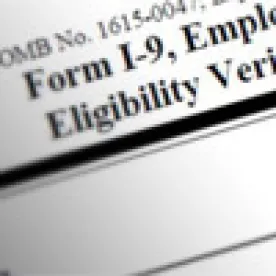The revised form is designed to reduce errors and ease completion.
On November 14, the US Citizenship and Immigration Services (USCIS) published a long-awaited revised version of Form I-9, Employment Eligibility Verification. The form will be mandatory starting January 22, 2017. Until that time, the Form I-9 with a revision date of March 8, 2013 will be accepted.
The revised Form I-9 has features intended to make it easier to complete on a computer and to reduce the likelihood of employer errors that could result in fines. New features in the online version include drop-down menus for dates, links to instructions, and an option to clear the form and start over. The form will allow for multiple preparers and translators and will have a dedicated area for including additional information.
Noteworthy, however, is that the new online form does not accept electronic signatures, and employers will need to print it, sign it by hand, and properly store and retain it. The new Form I-9 is also not connected electronically to E-Verify; accordingly, employers that use E-Verify must still process their E-Verify submissions separately.
The updated Form I-9’s new features include the following:
-
Validations on certain fields to ensure that information is entered correctly. The form will validate the correct number of digits for a Social Security number or an expiration date on an identity document, for example.
-
Drop-down lists and calendars.
-
Embedded instructions for completing each field.
-
Buttons that allow users to access the instructions electronically, print the form, and clear the form to start over.
-
Additional spaces to enter multiple preparers and translators. If an employee does not use a preparer or translator to assist in completing Section 1, the employee must indicate so on a new check box labeled "I did not use a preparer or translator."
-
The requirement that workers provide only other last names used in Section 1, rather than all other names used. This avoids possible discrimination issues and protects the privacy of transgender and other individuals who have changed their first names.
-
The removal of the requirement that immigrants authorized to work provide both their Form I-94 number and foreign passport information in Section 1.
-
A new "Citizenship/Immigration Status" field at the top of Section 2.
-
A dedicated area to enter additional information that employers are currently required to note in the margins of the form, such as Temporary Protected Status and Optional Practical Training extensions.
-
A quick-response matrix barcode, or QR code, that generates once the form is printed and can be used to streamline enforcement audits.
-
Separate instructions from the form. Employers must still present the instructions to the employee who completes the form, however.
Federal law requires that every employer that recruits, refers for a fee, or hires an individual for employment in the United States must complete Form I-9. Since November 1986, Form I-9 has been required under the Immigration Reform and Control Act.



 />i
/>i
